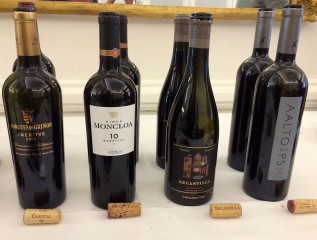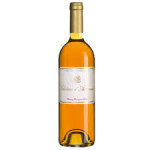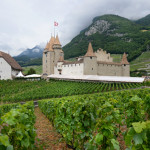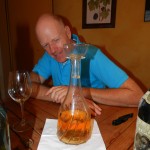Spain’s Grandes Pagos come to town

Some of the Grandes Pago España wines tasted in Lausanne
Photo: Ellen Wallace
A group of Spanish producers who form the Grandes Pagos de España association showed off some of their wines this week in Switzerland – in Zurich, Lausanne and Geneva. Some 20 members provided a nice contrast to the big industrial-style estates, a reminder that Spain has some beautiful wines being made at estates on a human scale. These are small producers of single-estate wines; the original wineries were from Old and New Castile, but in 2003 the association opened up to wineries from other regions, adding two a year. Today 30 wineries make up the group. Overall, these are fine wines, elegant and well made. A sommelier who was tasting alongside me complained that too many of them were presenting international style wines, rather than truly Spanish wines. I think they are making both – I admired but was indifferent to an oaked Chardonnay. It was the clearly Spanish wines, where their own grape varieties and terroir come through, that I loved. And I did fall in love with several!
My selections from the public tasting session and from one for professionals, led by Thomas Vaterlaus, editor of Europen wine magazine Vinum.
La Zarcita 2013 , Palacio Quemado, DO Ribera del Guadiana
The least expensive and a very pleasing wine from the southwest, the 2013 is the first vintage that is entirely organic. The winery, long famous for its Pedro Ximenez Wines, moved to organic growing in 2010. This wine is mainly Tempranillo with other blends, including some Syrah. This was one of the most down to earth and Spanish style terroir wines that I tasted Wednesday, a winner. This is also the newest member of the Grandes Pagos group, in February 2015. Notes of spices and coffee, with toasted notes from the oak still evident, it is young and lively and expressive; the winery is on a good path.
About CHF10-12 / Grandes Pagos
Selección Finca Montealto 2013 Bodegas Fillaboa, DO Rias Baixas
This northern winery, just above Portugal and virtually on the Atlantic in Spain’s northwest corner, makes just 10,000 bottles of this exquisite, perfumed yet delicate and very crisp (acidic) white with a long, dry finish, from 100% Albariño grapes. Rainfall is heavy here, with a softening influence from the Atlantic. The wine is matured on its lees for 15 months in stainless steel tanks. A very refreshing wine I’d be happy to drink year-round.
CHF25 / Distributor’s website
Emeritus 2008 Pagos Marqués de Griñon, DO Dominio de Valdepus
An international southern wine, and one to please a crowd. The winery is near Toleda, in olive grove and vineyard country. The wine is an inky purple, with a nose of blueberries, very fresh. This one is now six years old and the tannins are well integrated (they use old and new oak), giving a very smooth wine. It’s 63% Cabernet Sauvignon, 32% Petit Verdot, 5% Syrah, with 25 months in French oak, followed by two years in bottle before it is released.
CHF68 / Distributor’s website
Secastilla 2010, Viñas del Vero, DO Somontano
I’m not very familiar with Garnacha/Grenache on its own, despite the fact it is one of the world’s most widely grown grapes. It needs hot, dry conditions such as you can find in Spain, to thrive. It was immediately clear this is a very special example, with a nose of truly luscious concentrated fruit, thanks to vines that are 40 to 60 years old (fewer grapes, but all the goodness poured into those few). In mouth it almost had a CO2-like zippiness, very fresh. It spends 10 months in oak from France’s famed Allier forest. Thomas Vaterlaus declared it a “very great Grenache”; a less enthusiastic wine journalist noted that the wood is still very present. I found it noticeable but not offputting, and I think it will still be lovely in a couple of years, if you can find it – they make only 15,000 bottles and no one else in the area makes wine like this.
CHF37.90 / Distributor’s website
Aalto PS 2012, Aalto winery, DO Ribera del Duero
Easily my favourite, a splendid wine (do note the price)! I met the director, Javier Zaccagnini last October when I was in the region; he dashed into a dinner he’d almost forgotten because he was scrambling with his workers to pull in the harvest during an exceptionally rainy week. I was impressed that the grapes and the wine came first in his mind, and that’s he very much a man in the vines. His wine enchanted me then, and the one I tasted in Lausanne Wednesday night confirmed it.
The grapes come from nine villages along a strip that is roughly 50 km wide. These are very old Tempranillo (100%) vines, 60-90 years old. PS in the name stands for vine parcel selection: the best of the best here. A lesser and cheaper wine from these villages, called simply “Aaltos” is also good, but the “Aalto PS” is very special. 22 months in new French barrels. Nose and mouth are both marked by deeply rich black fruits and spices, a hint of licorice. Like all great wines it is complex and has a long finish. Wonderful now, but it should be at its best in 2-3 years, when the fruit will have developed even further. 20,000 bottles, not easy to find.
CHF99 / Distributor’s website
Pago Valdebellón, Abadia Retuerta, DO Vino de la Tierra de Castilla y Léon
I’ve bought this winery’s wines regularly over the years from the Divo wine club in Vaud, whose delivery system is wonderful. The seven from Abadia Retuerta they carry range in price from CHF29 to 110; this is listed at CHF80 and tasting the 2009, then the 2011 I could see why. The younger wine is very nice, but the older one is now coming into its time and, carafed briefly, it was a very big Cabernet Sauvignon. Possibly even more beautiful, but I had to imagine it with an exotic meal of Spanish lamb on a spit, is the (even more expensive) “Selección Especial 2011″, 75% Tempranillo 15% Cabernet Sauvignon and 10% Syrah.
CHF80 and CHF110.
Ellen Wallace
This article was first published in Geneva Lunch and in Ellen’s Wine World.









